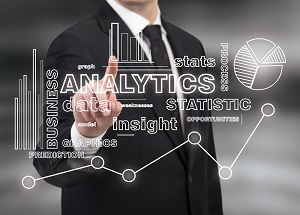Today, businesses are collecting staggering volumes of data about new and existing customers and marketplace expectations through social listening, real-time apps, cloud, and product performance data, to name a few. Predictive analytics is the combined result of Big Data with business intelligence (BI) to imagine the future. It provides a way to leverage collected information to detect patterns and envision likelihoods with statistical modeling. Predictive analytics is a core commitment for businesses that want to gather new insights for better decision-making and keep ahead of the competition.
Organizations can use predictive analytics in almost every sector such as data mining and predictive marketing to better understand and address customer needs, or when applying machine learning (ML) and artificial intelligence (AI) algorithms to optimize business processes, reduce or eliminate “low added-value” tasks, and support decision-making at every level. To deliver the best ROI from predictive analytics, it is important to understand what predictive analytics is and what it is not.
What are predictive analytics?
When professionals discuss “analytics,” it’s common to think of the terabytes of data collected and stored by organizations based on digital and physical behavior and feedback from users. That said, data analytics based on Big Data wasn’t harnessed until the mid-2000s after Roger Magoulas used the term “Big Data” to describe the vast amount of data that seemed almost “impossible” to process using the BI tools available at that time. This paved a path for the cloud-based software frameworks that process both structured and unstructured data collated from most digital sources businesses commonly operate with today. The main goal of complex data warehouses, architecture, and collection systems is to obtain necessary intelligence related to the business and its operations. Predictive analytics takes it a step further to see future potential paths. This access to mass data has fueled advancements across data science projects, day-to-day report generation, recommendation-based algorithms, and the development of AI and robotic process automation.
Predictive analytics, in conjunction with big data, BI, and automation, can help from the front to the back end of businesses. A predictive analytics workflow starts by importing data from varied sources, including internal communications and functions, customer databases, and external data sources. From there, data can be cleaned and aggregated to suit specific use cases or goals and develop an accurate predictive model utilizing statistical modeling, curve fitting tools, or machine learning. Predictive modeling is a complex process, not a singular event, so multiple iterations are necessary to ensure the right approach to develop a predictive analysis that incorporates necessary data and variables in a readable, visual format decision makers can use. With a successful model in hand, the forecasted data can be integrated into the production system to make the analytics available to end users across the organization within software programs or devices.
Overcoming the misconceptions of predictive analytics
Despite its clear value, many businesses are still learning to harness the benefits of a successful data platform that supports predictive analytics. This uphill battle has much to do with misunderstandings about what a data platform can and should do. Three misconceptions every business must overcome when developing a predictive analytics strategy include:
- Misconception #1: Thinking that predictive analytics is a one-time event. It’s common for businesses to think that simply adopting a data platform is enough to support predictive analytics. Instead, businesses must consider what they truly aim to accomplish with their data and implement the organizational, analytical, and actionable data processes that fuel BI for customer-centric decision-making.
- Misconception #2: Believing that collecting data and expecting it to offer insights is the same as committing to predictive analytics. Raw data isn’t as helpful as many may think. Think of raw data as raw materials, such as a bag of flour. To create something that can be consumed, like a piece of bread, those raw materials must be processed, cleaned, and manipulated to become truly useful.
- Misconception #3: Resource availability only impacts data storage. Again, raw data is only one part of the picture, meaning resources committed to data storage is only one element of resource requirements. Organizations must address that all integrated systems have the computer process capability to churn out predictive analytics at high volume and velocity, with the ability to scale for future growth.
Six steps to building a data platform that supports successful predictive analytics
A data platform is a centralized, entity-specific software for a business to store, access, organize, analyze, and visualize historical data and facts. When combined with predictive analytics using a range of statistical algorithms, analysts, developers, and business leaders can implement a successful data platform to enable ongoing analysis and dimensional modeling to better understand the customers, products, and partners. Data platforms are complex products with layers of storage, accessibility, and data governance systems at a minimum. What constitutes a “successful” data platform will look different for an enterprise-level company versus a start-up, or industry versus industry, but there are a few core layers that all data platforms must have to provide actionable insights, alongside vital strategy and mindset. To truly build a data platform that supports the business by identifying potential risks and opportunities for a company, it’s crucial to follow proven protocols:
- Commit to the journey. Predictive analytics is not a “switch on, switch off” button. Building a data platform is a constant commitment that requires dedication from the top down. If the data team is the only one devoted to quality data and predictions, the insights provided through statistical modeling won’t bear weight across the organization.
- Articulate goals clearly based on business requirements. It’s a vital step to define goals and targets to really understand what the business needs out of the platform. Again, this requires dedication and clear communication from leadership, but goalsetting can’t be a one-way street. Data teams and any teams utilizing the data need the option to offer feedback to foster alignment and transparency and set realistic goals.
- Position the right developers and managers in place with the skills aligned with objectives. Businesses require a dedicated team that can not only develop a data platform centered on business objectives, but also continue maintenance to ensure data quality, accessibility to the right teams, and data-driven insights, all embedded with a growth-oriented mindset.
- Incorporate seven essential layers of the data platform:
- Data collection from all desired data sources
- Reliable storage option that can scale to needs, making cloud-based storage the option of choice for many businesses
- Data quality framework to ensure data is accurate, complete, timely, and consistent with business requirements rules
- Data modeling processes to visually represent data for storage, analysis, and reporting
- Data governance solutions to authorize accessibility from different roles and control over the management of data assets
- A scalable computing resource to take raw data and clean it with BI to prepare data for analysis and reporting
- BI and analytics to translate data to real, actionable insights tailored to use for certain teams or initiatives.
- Implement a consistent testing process with KPIs to ensure goals are being met. A data analytics testing process validates all structured and unstructured data with a focus on achieving superior data quality to enable meaningful analytics. Key-performance-indicators (KPIs) are valuable metrics organization use to evaluate the effectiveness of their data management and analytics initiatives to ensure they are aligned with objectives and to identify areas for improvement.
- Be future-ready with a scalable platform. For predictive analytics to benefit an organization, the platform and processes must be scalable to the growth of the business. By incorporating batch processing and streaming of the data, businesses can be prepared to accept any form of data at any velocity and size.
Preparing for the future can happen now
In today’s digitally transformed marketplace, rapid future-oriented change seems to arrive faster each day. A predictive data and analytics platform aligned with business objectives is no longer an option but a necessity. While this requires complex data warehouses, architectures, and collection systems to ensure the mass amounts of customer and business data at the organization’s fingertips can be utilized to make actionable, data-driven decisions that benefit the company, it also requires a growth mindset across the organization. When a business can access organized intelligence around their own operations and customers, they can leverage predictive analytics to envision a successful path toward continued progress in the future.
About the Author

Koushik Nandiraju is an award-winning data engineer with extensive experience preparing data while developing, constructing, testing, and maintaining complete data architecture. He holds a Master of Science in Applied Computer Science from Frostburg State University. For more information, please email koushiknandiraju@gmail.com.
Sign up for the free insideBIGDATA newsletter.
Join us on Twitter: https://twitter.com/InsideBigData1
Join us on LinkedIn: https://www.linkedin.com/company/insidebigdata/
Join us on Facebook: https://www.facebook.com/insideBIGDATANOW





Speak Your Mind